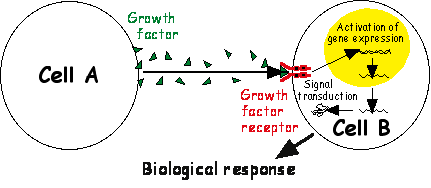Growth factor regulation of lymphangiogenesis
All cells in our body need oxygen and they receive it via the circulating blood. That's why the vascular system is the first organ system to function in a developing embryo. Before the heart starts pumping, the embryo's need for oxygen has to be met by diffusion alone. But diffusion is sufficient only until the embryo reaches a size of several millimetres.
Tumours face the same problem, when reaching a similar size. Both the developing embryo and the solid tumor can only continue growing if they manage to establish a circulatory system that supplies them with oxygen and nutrients.
While cancer depends on the pathological growth of blood vessels, other diseases are caused by insufficient vascular function. E.g. in cardiovascular disease the blood vessels cannot deliver enough oxygen to the heart muscle. Apart from the cardiovascular system there is another vascular system: the lymphatic system. It functions mainly in tissue drainage and immune defense against pathogens. Similar to the cardiovascular function, the lymphatic system plays an important role in several diseases. E.g. in lymphedema patients suffer from swollen limbs because lymphatic vessels are absent or not functioning properly. And the spread of cancer ("metastasis") seems to be intimately related to the lymphatic system as the cancer cells use the lymphatic vessels as pathways to travel within the body.

It is obvious that many diseases could be treated if we would be able to influence the growth of both blood and lymphatic vessels. This is where our research focuses on.
Talking Cells
The human body consists of several trillion cells. To avoid chaos, all these cells have to communicate. A simple model of communication is shown below. Cell A sends a message by producing a signalling molecule. Cell B recognizes the signalling molecule, because it has receptors, that fit to the signalling molecule like a key to its keyhole ('receptor binding'). Cell B responds to the message by changing its behavior. Growth factors are such signalling molecules. Hundreds of different growth factors are known and everyone delivers a special message from one cell to another.

Our laboratory works on growth factors, that regulate the development and function of blood vessels and lymphatic vessels. After reaching a size of several millimeters a developing embryo can only continue growing by establishing a circulatory system that supplies all of its cells with oxygen and nutrients. Blood vessels consist mainly of endothelial cells and are formed by two different mechanisms: vasculogenesis and angiogenesis.
Vasculogenesis
The earliest blood vessels of an embryo form by vasculogenesis. Vasculogenesis is the differentiation of endothelial cells from precursor cells (angioblasts). Angioblasts aggregate and form blood islands.
Cells at the periphery become endothelial cells; cells in the centre become blood cells. Vasculogenesis forms the early heart rudiment, the major blood vessels and the vessels of lung, spleen and pancreas.
Angiogenesis
Angiogenesis is the sprouting of new blood vessels from pre-existing vessels.

Angiogenesis is responsible for the vascularization of developing organs like the brain, kidney and limbs. The most important growth factor that makes blood vessels grow is Vascular Endothelial Growth Factor (VEGF). VEGF binds two different receptors: VEGF receptor-1 (VEGFR-1) and VEGF receptor-2 (VEGFR-2).
Lymphangiogenesis
The lymphatic system develops later than the cardiovascular system. All lymphatic vessels arise by angiogenesis. The first lymphatic vessels sprout from the venous compartment of the circulatory system. The only known growth factor, that stimulates the growth of lymphatic vessels was cloned in our laboratory: VEGF-C. VEGF-C binds to VEGF receptor-2 and VEGF receptor-3 (VEGFR-3). Blood vessel growth in adults The blood vessels of a fully developed organism only need to grow under special circumstances, e.g. in wound healing. Blood vessel growth in adults occurs almost exclusively by angiogenesis.



